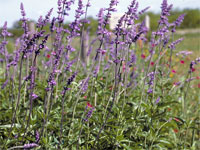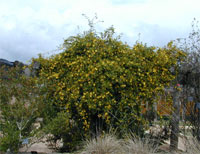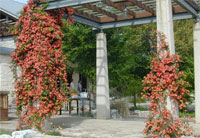Wild About Texas – March, 2010
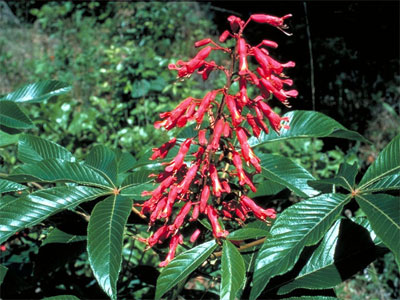
Scarlet buckeye (Aesculus pavia), also know as red buckeye and firecracker plant, features red tubular flowers that are especially attractive to hummingbirds.
Gardening for Hummingbirds
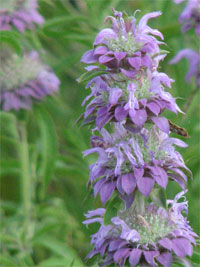
Horsemint
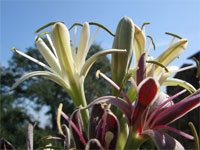
False aloes
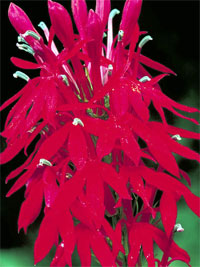
Cardinal flower
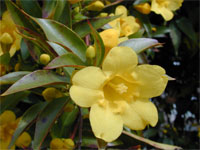
Carolina jessamine, up close
Regardless of what the calendar says, spring for me arrives with the hummingbirds. Over my lifetime I’ve enjoyed scores of hours observing these nimble airborne acrobats, and to this day I am never bored. Devoutly territorial, bold, liquidly lissome, and forever ravenous, these flying jewels are endlessly entertaining. Attracting them to your garden provides a satisfying opportunity to watch their aerial antics.
By far, the two most common species whirring through Texas skies are the ruby-throated of the eastern U.S. and the black-chinned denizen of the western states. In Texas, their ranges overlap in the middle of the state. Other species to look out for, especially in the western counties, are broad-tailed, rufous, magnificent, and Anna’s hummingbirds.
Here are a few tips to guide you in creating a suitable setting for hummingbirds:
• Hummingbirds need a variety of nectar-rich flowers that bloom continuously or consecutively throughout the seasons of visitation, roughly April through October, depending on the region of the state and the weather. See the list below for a few garden favorites.
• Sweet sap accessible from fresh woodpecker holes provides another source of nutrition.
• In addition to nectar and sap, hummingbirds also eat small insects and spiders, especially when they are with young. Be conscientious when using pesticides, even organic, as they can be harmful.
• Since many nectar-loaded plants flower close to the ground, it is imperative to protect the birds from predacious housecats.
• Although nectar is the main source of water for hummingbirds, fresh is also appreciated, particularly in hot dry weather. Moving water catches their attention, and sprinklers and gentle waterfalls are a big hit, as long as there isn’t too much splashing. Still water is also good for bathing and drinking and should be shallow enough for them to stand in.
• Feeders are not necessary if you have a good selection of nutrient-packed flowers, but they can be useful to bring hummingbirds to a convenient viewing site such as a window or outdoor seating area. Make your own solution with 1:4 sugar to water. Boil the solution, and allow to cool before filling the feeder. Frequent cleaning of feeders keeps the birds healthy and coming back; it should be done every few days, and more frequently during hot spells.
• Perches allow for rest and territorial monitoring. Branches and twigs of trees or shrubs, fences, telephone lines, and large herbaceous plants with open branching are all appropriate.
Hummingbirds have a weak sense of smell and are cued largely by vision. Most of us know to offer long, tubular-shaped flowers of red or orange, but the hummers will come to blossoms of other hues as well. Here are a few top-rated Texas natives guaranteed to please:
Annuals and biennials
Cardinal flower (Lobelia cardinalis)
Columbine (Aquilegia canadensis, others)
Coral yucca (Hesperaloe parviflora)
False aloes (Manfreda spp.)
Monarda spp. (horsemint, beebalm, bergamot, others)
Penstemon spp.
Purple coneflower (Echinacea purpurea)
Salvia spp. (tropical sage, mealy blue sage, big red sage, cherry sage, cedar sage, blue shrub sage, others)
Standing cypress (Ipomopsis rubra)
Texas lantana (Lantana urticoides, aka. L. horrida)
Turk’s cap (Malvaviscus arboreus var. drummondii)
Shrubs and small trees
Azaleas (Rhododendron spp.)
Buckeyes (Aesculus spp.)
Coral bean (Erythrina herbacea)
Desert willow (Chilopsis linearis)
Flame acanthus (Anisacanthus quadrifidus var. wrightii)
Hibiscus spp.
Ocotillo (Fouquieria splendens)
Yellowbells (Tecoma stans)
Vines
Carolina jessamine (Gelsemium sempervirens)
Coral honeysuckle (Lonicera sempervirens)
Crossvine (Bignonia capreolata)
Morning glories (Ipomoea spp.)
Snapdragon vine (Maurandella antirrhiniflora, aka Maurandya antirrhiniflora)
Trumpet creeper (Campsis radicans)
For more information about Texas native plants, visit the Wildflower Center’s website at www.wildflower.org.
About the author: Andrea DeLong-Amaya is the director of horticulture at the Lady Bird Johnson Wildflower Center in Austin.


